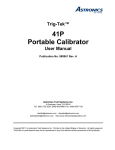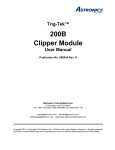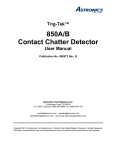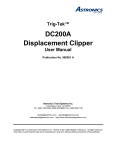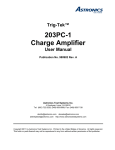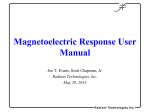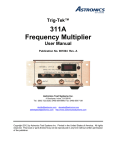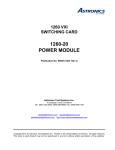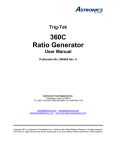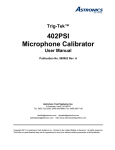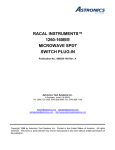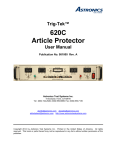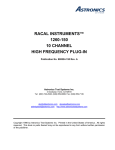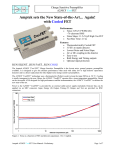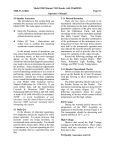Download Trig-Tek™ 201AP Charge Amplifier User Manual
Transcript
Trig-Tek™ 201AP Charge Amplifier User Manual Publication No. 980996 Rev. A Astronics Test Systems Inc. 4 Goodyear, Irvine, CA 92618 Tel: (800) 722-2528, (949) 859-8999; Fax: (949) 859-7139 [email protected] [email protected] [email protected] http://www.astronicstestsystems.com Copyright 2012 by Astronics Test Systems Inc. Printed in the United States of America. All rights reserved. This book or parts thereof may not be reproduced in any form without written permission of the publisher. THANK YOU FOR PURCHASING THIS ASTRONICS TEST SYSTEMS PRODUCT For this product, or any other Astronics Test Systems product that incorporates software drivers, you may access our web site to verify and/or download the latest driver versions. The web address for driver downloads is: http://www.astronicstestsystems.com/support/downloads If you have any questions about software driver downloads or our privacy policy, please contact us at: [email protected] WARRANTY STATEMENT All Astronics Test Systems products are designed to exacting standards and manufactured in full compliance to our AS9100 Quality Management System processes. This warranty does not apply to defects resulting from any modification(s) of any product or part without Astronics Test Systems express written consent, or misuse of any product or part. The warranty also does not apply to fuses, software, non-rechargeable batteries, damage from battery leakage, or problems arising from normal wear, such as mechanical relay life, or failure to follow instructions. This warranty is in lieu of all other warranties, expressed or implied, including any implied warranty of merchantability or fitness for a particular use. The remedies provided herein are buyer’s sole and exclusive remedies. For the specific terms of your standard warranty, contact Customer Support. Please have the following information available to facilitate service. 1. Product serial number 2. Product model number 3. Your company and contact information You may contact Customer Support by: Fax: E-Mail: [email protected] Telephone: +1 800 722 3262 +1 949 859 7139 (USA) (USA) RETURN OF PRODUCT Authorization is required from Astronics Test Systems before you send us your product or sub-assembly for service or calibration. Call or contact Customer Support at 1-800-722-3262 or 1-949-859-8999 or via fax at 1-949-859-7139. We can also be reached at: [email protected]. If the original packing material is unavailable, ship the product or sub-assembly in an ESD shielding bag and use appropriate packing materials to surround and protect the product. PROPRIETARY NOTICE This document and the technical data herein disclosed, are proprietary to Astronics Test Systems, and shall not, without express written permission of Astronics Test Systems, be used in whole or in part to solicit quotations from a competitive source or used for manufacture by anyone other than Astronics Test Systems. The information herein has been developed at private expense, and may only be used for operation and maintenance reference purposes or for purposes of engineering evaluation and incorporation into technical specifications and other documents which specify procurement of products from Astronics Test Systems. TRADEMARKS AND SERVICE MARKS All trademarks and service marks used in this document are the property of their respective owners. • Racal Instruments, Talon Instruments, Trig-Tek, ActivATE, Adapt-A-Switch, N-GEN, and PAWS are trademarks of Astronics Test Systems in the United States. DISCLAIMER Buyer acknowledges and agrees that it is responsible for the operation of the goods purchased and should ensure that they are used properly and in accordance with this document and any other instructions provided by Seller. Astronics Test Systems products are not specifically designed, manufactured or intended to be used as parts, assemblies or components in planning, construction, maintenance or operation of a nuclear facility, or in life support or safety critical applications in which the failure of the Astronics Test Systems product could create a situation where personal injury or death could occur. Should Buyer purchase Astronics Test Systems product for such unintended application, Buyer shall indemnify and hold Astronics Test Systems, its officers, employees, subsidiaries, affiliates and distributors harmless against all claims arising out of a claim for personal injury or death associated with such unintended use. FOR YOUR SAFETY Before undertaking any troubleshooting, maintenance or exploratory procedure, read carefully the WARNINGS and CAUTION notices. This equipment contains voltage hazardous to human life and safety, and is capable of inflicting personal injury. If this instrument is to be powered from the AC line (mains) through an autotransformer, ensure the common connector is connected to the neutral (earth pole) of the power supply. Before operating the unit, ensure the conductor (green wire) is connected to the ground (earth) conductor of the power outlet. Do not use a two-conductor extension cord or a three-prong/two-prong adapter. This will defeat the protective feature of the third conductor in the power cord. Maintenance and calibration procedures sometimes call for operation of the unit with power applied and protective covers removed. Read the procedures and heed warnings to avoid “live” circuit points. Before operating this instrument: 1. Ensure the proper fuse is in place for the power source to operate. 2. Ensure all other devices connected to or in proximity to this instrument are properly grounded or connected to the protective third-wire earth ground. If the instrument: - fails to operate satisfactorily shows visible damage has been stored under unfavorable conditions has sustained stress Do not operate until performance is checked by qualified personnel. Publication No. 980996 Rev. A 201AP User Manual Table of Contents Chapter 1 .........................................................................................................................1-1 Introduction .....................................................................................................................1-1 Specifications ................................................................................................................................. 1-2 Input ........................................................................................................................................... 1-2 AC Output................................................................................................................................... 1-2 Power ......................................................................................................................................... 1-2 Dimensions ................................................................................................................................ 1-2 Chapter 2 .........................................................................................................................2-1 Operation .........................................................................................................................2-1 GAIN Setting................................................................................................................................... 2-1 Filter................................................................................................................................................ 2-1 Chapter 3 .........................................................................................................................3-1 Performance ....................................................................................................................3-1 Test Equipment .............................................................................................................................. 3-1 Procedure ....................................................................................................................................... 3-1 Astronics Test Systems i 201AP User Manual Publication No. 980996 Rev. A This page intentionally left blank. ii Astronics Test Systems Publication No. 980996 Rev. A 201AP User Manual List of Figures Figure 1-1. Trig-Tek 201AP Charge Amplifier ................................................................................... 1-1 Figure 2-1. Filter Plug-in Assembly ................................................................................................... 2-2 Astronics Test Systems iii 201AP User Manual Publication No. 980996 Rev. A DOCUMENT CHANGE HISTORY iv Revision Date A 12/3/2012 Description of Change Document Control release Astronics Test Systems Publication No. 980996 Rev. A 201AP User Manual Chapter 1 Introduction The Trig-Tek™ 201AP Charge Amplifier (Figure 1-1) is designed to amplify the outputs from piezoelectric or mV type accelerometers, force gauges, microphones, and pressure pickups. The CHARGE output from the pickup, expressed in millivolts or picocoulombs per g, is then amplified and AC signal proportional to the input is brought out via a BNC connector. The AC voltage output can be used to operate vibration monitors, recorders, analyzers, etc. The unit includes a four-section low pass filter. The cutoff frequency can be selected by a changing resistor values on a plug-in assembly. (See Figure 2-1.) Nominal -3dB cutoff is 20 kHz. Cutoff frequencies up to 50 kHz and down to 500 Hz can be accomplished by changing the resistor values on the assembly. Figure 1-1. Trig-Tek 201AP Charge Amplifier Astronics Test Systems Introduction 1-1 201AP User Manual Publication No. 980996 Rev. A Specifications Input PC or mV Changed by a movable jumper on the PC board (S1 location). The 201AP is set to PC mode at the factory. Frequency – 3 dB 1 Hz to 100 kHz (no filter) Sensitivity 0.1 - 1.0, 1.0-11 mV/pC continuously in conjunction with the GAIN switch Pyro Electric Amplifier will not block Input Shunt Resistance Will operate with shunt resistance down to 1 MegOhm mV Mode 3-5 mA current (optional) Connector 10-32 microdot Impedance Less than 50 Ohms (10 ma) Voltage 5 Volts RMS full scale Frequency Response ±5%, 5 Hz to 50 KHz (no filter) Amplitude Linearity 0.5% of full scale Harmonic Distortion Less than 1% Connector BNC Power ±12 to ±18 Volts DC at approximately 15 mA AC Output Power Dimensions Dimensions Introduction 1-2 5.25" long x 2.5" wide x 1.66" deep (13.3 cm x 6.3 cm x 4.2 cm) Astronics Test Systems Publication No. 980996 Rev. A 201AP User Manual Chapter 2 Operation The Trig-Tek 201AP Charge Amplifier provides a low cost unit, packaged in a rugged container, for mounting close to the accelerometer in the engine test cell or the vibration laboratory. It will accept at its input an accelerometer output and provides gain from 0.1 to 1.1 mV/pC, or 1 to 11 mV/pC as selected by the GAIN switch. The unit requires ±12 to ±18 Volts power at approximately 15 milliamps. The continuously variable gain adjustment should be set to accommodate the sensitivity of the pickup being used. The unit can operate with either picocoulomb or millivolt type pickups. GAIN Setting To properly set the gain of the amplifier it is necessary to know the sensitivity of the pickup being used, the full scale g range, and the mV/g required at the output. With this information, the proper gain can be set. Multiply the total full scale g range times the pickup sensitivity. This gives the total millivolts or picocoulomb at the input. Connect a generator to the input set for the determined level and set the gain for the required output level. For instance, set the unit to accommodate a 50 pC or mV/g pickup and provide a 10 mV/g output, connect a pC or mV signal from a generator to the input of the Charge Amplifier, and set the generator for 1000 pC or mV at 100 Hz. Dividing 1000 pC or mV by 50 pC or mV/g equals 20 g's peak at the input to the Charge Amplifier. Connect a voltmeter to the output of the Charge Amplifier, and set the GAIN ADJ of the Charge Amplifier for a 200 mV Peak indication. This calibrates the unit for 10 mV/g. Filter The 201AP has a four-section low pass filter to roll off the high frequency end of the pass band. The resistors for the filter are on an 8-pin plug-in assembly (Figure 2-1). The unit is normally set for -3 dB cutoff at approximately 20 kHz. Should you want to change the cutoff; the four equal resistors on the assembly can be increased to lower the cutoff frequency, or decreased to increase the cutoff frequency. Astronics Test Systems Operation 2-1 201AP User Manual Publication No. 980996 Rev. A Figure 2-1. Filter Plug-in Assembly Operation 2-2 Astronics Test Systems Publication No. 980996 Rev. A 201AP User Manual Chapter 3 Performance The following performance test should be run to verify that the unit is performing within the manufacturer's specifications. Test Equipment Note: Equivalent equipment can be substituted. Digital Voltmeter Fluke 8000A Signal Generator Astronics Test Systems 346B Synthesized Calibrator Voltage-to-Charge Converter Astronics Test Systems 2030 (built into the 346B) Procedure 1. Connect the ±12 to ±18 Volts power of approximately 15 milliamps to the unit. 2. The 201AP has an internal jumper to select either pC or mV mode. When shipped, it will be in the pC Mode. 3. Connect a sine wave signal of 500 ±10 mV RMS and about 100 Hz to the input. When in the picocoulomb mode connect the input through a voltage to charge converter. 4. Turn the GAIN potentiometer all the way clockwise and set the GAIN Switch to 1-11. 5. Connect the AC Voltmeter to the output terminal marked AC. (The meter common to the terminal marked COM.) 6. Observe an indication of 500 mV RMS or less. 7. Set the GAIN Switch to 0.1-1.1. 8. Observe an indication of 50 mV or less. 9. Turn the GAIN potentiometer all the way counterclockwise. 10. Observe indication of 500 mV or more. Astronics Test Systems Calibration 3-1 201AP User Manual Publication No. 980996 Rev. A 11. Set the GAIN Switch to 1-11. 12. Observe an indication of 5.00 Volts RMS or more. 13. Change the input frequency to 20,000 Hz. 14. Observe an indication of 3.50 volts RMS ±1.00 volts RMS on the AC Voltmeter. 15. The frequency response of the unit can be checked by changing the frequency in the pass band region and observing the AC output voltage. (If you go below 30 Hz, you have to use a DC coupled oscilloscope, because the frequency of the AC meter may deteriorate below 30 Hz.) It should be ±5% down to 5 Hz, and the high will be controlled by the cutoff frequency of the low pass filter. Calibration 3-2 Astronics Test Systems















